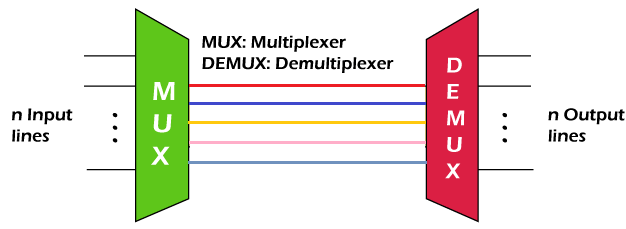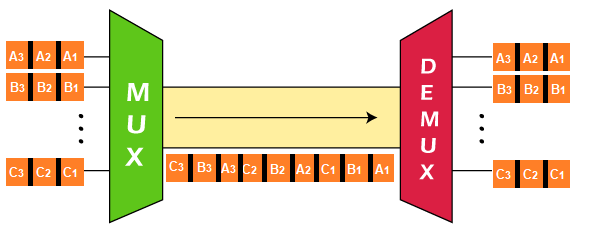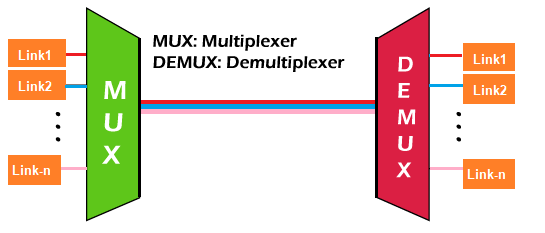MultiplexingMultiplexing is a process to send one or more signals over the same communication channel. The modulation process (Amplitude Modulation or Angle Modulation) is an example of multiplexing as both the message signal and the carrier signal are transmitted on the single communication channel. The main advantage of multiplexing is the multiple transmissions on the same communication channel. A channel acts as a medium between the transmitter and the receiver. It transmits the modulated signal received from the transmitter and sends it to the receiver. The receiver demodulates the received signal to recover the original form of signal. There are various communication channel types, such as optical fiber, coaxial cable, twisted pair cables, etc. These sources of communication channel transmit the data to long distances like Wi-Fi and two-way communication. We can also define multiplexing as the process of sharing a channel between multiple signals. Multiplexing and ModulationThe transmission of a single-channel is called modulation, while multiple transmissions are called multiplexing. The function of modulation is to vary the properties of the incoming message signal depending on the output requirements. The function of multiplexing is to combine various signals. So, both the terms (modulation and multiplexing) modulate the signal and transmit it to the communication channel and are widely used in communication. In the demodulation, the receiver captures the signal and converts it back to its original form. Similarly, the recovery of multiple signals back to their original form is known as demultiplexing. A simple diagram of multiplexing (MUX) and demultiplexing (DEMUX) is shown below: 
In multiplexing, various signals are transmitted at different frequencies. It avoids any interference or mixing between the signals and helps in their easy separation at the receiving end. Types of MultiplexingThere are five types of multiplexing, which are as follows:
FDMFrequency Division Multiplexing refers to the multiplexing method where the total bandwidth of the channel is divided with respect to the frequency or frequency bands. It allows multiple signals of different frequencies to share a common channel, such as optical fiber. Each frequency band is different from the other and carries a separate signal. The signal in the form of bitstreams is also transmitted similarly. Another method is transmitting the higher-order bitstreams in parallel. A parallel combination sends multiple bits at a time, as shown below: 
The signals that are sent on a single communication channel are known as baseband signals. The transmitter consists of an electronic oscillator, modulator, and filters. The electronic oscillator generates a high frequency carrier signal, which carries information. The modulator combines the carrier signal and the baseband signal. It also alters the characteristics of the baseband signal, such as amplitude, frequency, or phase depending on the requirements. The filters can be used to reduce any noise or attenuation. The output of the modulator produces the sum and difference of modulating and carrier frequencies. The information is present in the two sidebands, which are present at both the sides of the carrier wave. Similarly, other signals at different frequencies are transmitted creating other channels of information. Examples of FDMLet's discuss the most common examples of FDM.
Television Broadcasting Television broadcasting refers to the process of sending multiple television signals on the same channel. All independent channels are transmitted with different frequencies to prevent any cross talk or interference. For example, Cable television In cable broadcasting, multiple signals are transmitted using a single cable. It generally sends various television channels simultaneously on a single cable, such as coaxial cables. Radio Broadcasting Radio broadcasting refers to the process of sending multiple radio signals on the same channel (air). All independent channels are transmitted with different frequencies to prevent any cross talk or interference. The transmission is carried with the help of an antenna that sends and receives radio signals. Telephone Broadcasting Telephone broadcasting also refers to the process of sending multiple telephones or audio signals on the same channel (telephone line). Telephone broadcasting uses communication satellites, broadband, modems, radio beams, etc., to transmit signals from one place to another. For example, twisted pair cable lines. Advantages of FDMThe advantages of FDM are as follows:
Disadvantages of FDMThe disadvantages of FDM are as follows:
TDMTime Division Multiplexing refers to the multiplexing method where the total bandwidth of the channel is divided with respect to the time slots. TDM has the advantage of utilizing the maximum transmission channel bandwidth as compared to other types of multiplexing. It uses time instead of frequency to separate the signals or data streams arranged in the sequence one after the other. It helps the receiver to recover the information in respective order. A time gap is selected based on which the signals are transmitted. For example, Pulse Modulation It is an analog modulation technique based on TDM. In pulse modulation, the data in the form of pulses varying in amplitude, frequency, or phase are transmitted. The space or gap between the two pulses can be utilized by other pulses for transmission. A simple block diagram explaining the transmission of data using the TDM technique is shown below: 
The above diagram has three bits in each input. It depicts that each bit of a particular input is arranged in a specific sequence, which is the same for n number of input bits. Each bit of every input is arranged in sequential order. Similarly, n numbers of bits are transmitted using TDM. TDM is further categorized as:
Synchronous TDM The time slots in synchronous TDM are pre-assigned to each frame. Any delay in the transmission of data may result in the empty transfer of data. It means that a slot is transmitted empty if it is not used at the assigned time. Asynchronous TDM The time slots in asynchronous TDM are flexible to each frame. The data can be assigned to the time slot when the connected devices are ready to transmit the data. It means that a slot cannot be transmitted empty. It does not allow any wastage of a specific time slot. Advantages of TDMThe advantages of TDM are as follows:
Disadvantages of TDMThe disadvantages of TDM are as follows:
CDMCode Division Multiplexing is a technique that uses a coding scheme for the transmission process. It assigns a code to every transmitter. Each transmitter with a different code is transmitted on the same communication channel and demultiplexing using the same process. The coding scheme secures the transmission process with less interference. The concept of CDMA (Code Division Multiple Access) in digital communication is the same as CDM and allows multiple users to share a common communication channel. The code of every station cannot interfere because a code of a station multiplied by the other always yields 0. A code of a station can be multiplied by itself, which yields a positive number. Advantages of CDMThe advantages of CDM are as follows:
Disadvantages of CDMThe disadvantages of CDM are as follows:
SDMSpace Division Multiplexing is used to transmit the independent channels in space. It is also known as Spatial Multiplexing. It is commonly used in wireless technologies, such as fiber optics and Wi-Fi. Optical fiber transmission can use a single-core optical fiber, multicore optical fiber, and bundles of fibers to transmit the data from the transmitter to the receiver. In the case of wireless transmission through space, multiple antennas at the transmitting and receiving sides are incorporated. The channel separation is maintained by using insulation and waveguides. For example, SDMA (Space Division Multiple Access)It is a digital communication multiplexing method that uses a point-to-point conductor for each channel in the communication system. It is generally used in mobile communication where a channel can be reused for the transmission process. It offers high capacity spatial multiplexing using advanced antenna technology to transmit multiple signals on the same communication channel. The use of advanced technology helps in filtering the noise or interference from the incoming signals. Advantages of SDMThe advantages of SDM are as follows:
Disadvantages of SDMThe disadvantages of SDM are as follows:
PDMPolarization Division Multiplexing is an optical fiber transmission technique that uses polarization of EM (Electromagnetic) waves. Polarization refers to the vibrations in a wave traveling in a specific direction. EM waves carry electromagnetic energy like X-rays, infrared, infrared, etc. It allows two-channel carrying information to transmit based on the same carrier frequency by using two orthogonal polarization states. It is commonly used for VHF (Very High Frequency) applications, such as satellite communication and fiber optics. The two orthogonally polarized antennas in the microwave satellite communication increase the total bandwidth to twice. A dual-polarized signal can carry upto two independent data streams, while a single polarized signal can carry or receive only one data stream at a time. PDM allows high transmission speed upto 100G/ bits. It is generally used with optical QAM (Quadrature Amplitude Modulation) and Phase Modulation. There Advantages of PDMThe advantages of PDM are as follows:
Disadvantages of PDMThe disadvantages of PDM are as follows:
WDMWavelength Division Multiplexing is also a type of optical communication that takes place through the optical fiber. It allows the transmission of multiple signals with different wavelengths or colors (laser). It is also called as wavelength duplexing or bidirectional multiplexing because it allows the transmission in both directions. All the signals are combined and transmitted through a single optical fiber. Demultiplexer at the receiving end split the incident beam into the separate signals as the output. The links or signal sources are known as transducers. A simple diagram of WDM is shown below: 
WDM is further categorized as CWDM and DWDM. CWDM (Course Wavelength Division Multiplexing) can operate upto 8 channels with a separation of 20 nanometers between every two adjacent channels. It is inexpensive and consumes less power. DWDM (Dense Wavelength Division Multiplexing) can operate with larger number of channels. It is expensive and transmits huge data through a single optical fiber link. Advantages of WDMThe advantages of WDM are as follows:
Disadvantages of WDMThe disadvantages of WDM are as follows:
Applications of MultiplexingThere are various applications of multiplexing. Let's discuss some of the most common applications.
Next TopicClassification of Transmitters
|
 For Videos Join Our Youtube Channel: Join Now
For Videos Join Our Youtube Channel: Join Now
Feedback
- Send your Feedback to [email protected]
Help Others, Please Share










